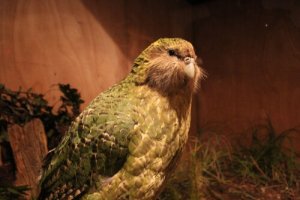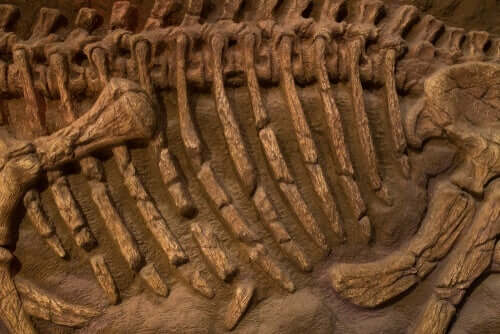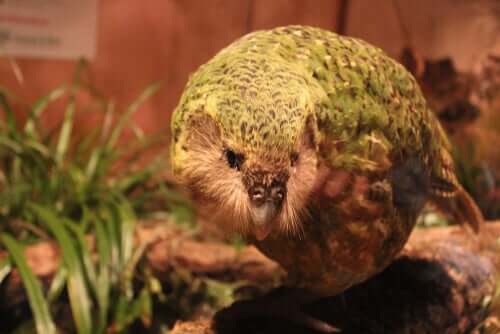A Giant Parrot Has Been Discovered in New Zealand!


Written and verified by the vet Eugenio Fernández Suárez
A giant parrot isn’t the kind of thing you find every day. The extreme unexpectedness of this finding, and the huge nature of the fossil they dug up has led scientists to name this extinct species of bird the Heracles inexpectatus. Read on to learn more about it!
The unexpected finding of a giant parrot!
The remains of this parrot were found in Central Otago, a part of New Zealand known for having countless fossils from the Miocene epoch. That’s the epoch to which this 19 million-year-old parrot species belongs, according to the researchers who found it.

It’s not the first time people have found fossils of extinct animal species that seem similar to animals alive now, but much bigger. For example, there are the gigantic lemurs of Madagascar. The theory goes that their extinction had a lot to do with the presence of human beings on the island.
In this case, the giant parrot looks extremely similar to a species of Psittaciform that’s still alive now. That animal is the very strange kakapo (Strigops habroptilus). It’s an odd species, and unfortunately at critical risk of extinction. Like the giant parrot, these are unable to fly because of their weight (over 6 pounds), but are good at camouflaging themselves.
As for the giant parrot, it could be over three feet tall. Weight-wise, they could easily reach 15 pounds, which is absolutely massive compared to the parrots we see nowadays.
A spectacular species of bird
The history of this giant bird is also very similar to the histories of other large birds that couldn’t fly. That seems to be what happened with the elephant bird, an extinct species from Madagascar. New Zealand is no stranger to huge bird species, either. One good example is the moa – large New Zealand birds similar to ostriches.

Many of these massive bird species went extinct very quickly because of human intervention. Not being able to fly made them very easy for the hunter-gatherer people to capture. Of course, that wouldn’t have been the case with this giant parrot, because its fossil record dates way farther back than humans in New Zealand.
This species would have lived in New Zealand when it had a subtropical climate, surrounded by laurel and palm trees. They had powerful beaks that gave the ability to eat just about anything they found on the ground. This is also the case with its modern cousin, the kakapo.
An important find
That said, we actually don’t know all that much about this species of bird compared to other animals from its epoch. But it’s also an absolutely unheard-of finding, and an important one for our understanding of parrots and their ancestors.
The Heracles inexpectatus belonged to a group of birds very similar to current New Zealand parrots like the kakapo and the kea. These species are actually very different from current Psittaciform species like the macaw, the parakeet, and the cockatoo. These ones are much more colorful and vibrant, and don’t camouflage well into their surroundings.
It’s thanks to the tireless work of archaeologists that we find all these new species, and this is no accident. Keep an eye on New Zealand if you’re interested in these kinds of things, because the finds probably haven’t ended yet!
A giant parrot isn’t the kind of thing you find every day. The extreme unexpectedness of this finding, and the huge nature of the fossil they dug up has led scientists to name this extinct species of bird the Heracles inexpectatus. Read on to learn more about it!
The unexpected finding of a giant parrot!
The remains of this parrot were found in Central Otago, a part of New Zealand known for having countless fossils from the Miocene epoch. That’s the epoch to which this 19 million-year-old parrot species belongs, according to the researchers who found it.

It’s not the first time people have found fossils of extinct animal species that seem similar to animals alive now, but much bigger. For example, there are the gigantic lemurs of Madagascar. The theory goes that their extinction had a lot to do with the presence of human beings on the island.
In this case, the giant parrot looks extremely similar to a species of Psittaciform that’s still alive now. That animal is the very strange kakapo (Strigops habroptilus). It’s an odd species, and unfortunately at critical risk of extinction. Like the giant parrot, these are unable to fly because of their weight (over 6 pounds), but are good at camouflaging themselves.
As for the giant parrot, it could be over three feet tall. Weight-wise, they could easily reach 15 pounds, which is absolutely massive compared to the parrots we see nowadays.
A spectacular species of bird
The history of this giant bird is also very similar to the histories of other large birds that couldn’t fly. That seems to be what happened with the elephant bird, an extinct species from Madagascar. New Zealand is no stranger to huge bird species, either. One good example is the moa – large New Zealand birds similar to ostriches.

Many of these massive bird species went extinct very quickly because of human intervention. Not being able to fly made them very easy for the hunter-gatherer people to capture. Of course, that wouldn’t have been the case with this giant parrot, because its fossil record dates way farther back than humans in New Zealand.
This species would have lived in New Zealand when it had a subtropical climate, surrounded by laurel and palm trees. They had powerful beaks that gave the ability to eat just about anything they found on the ground. This is also the case with its modern cousin, the kakapo.
An important find
That said, we actually don’t know all that much about this species of bird compared to other animals from its epoch. But it’s also an absolutely unheard-of finding, and an important one for our understanding of parrots and their ancestors.
The Heracles inexpectatus belonged to a group of birds very similar to current New Zealand parrots like the kakapo and the kea. These species are actually very different from current Psittaciform species like the macaw, the parakeet, and the cockatoo. These ones are much more colorful and vibrant, and don’t camouflage well into their surroundings.
It’s thanks to the tireless work of archaeologists that we find all these new species, and this is no accident. Keep an eye on New Zealand if you’re interested in these kinds of things, because the finds probably haven’t ended yet!
All cited sources were thoroughly reviewed by our team to ensure their quality, reliability, currency, and validity. The bibliography of this article was considered reliable and of academic or scientific accuracy.
https://doi.org/10.1098/rsbl.2019.0467
This text is provided for informational purposes only and does not replace consultation with a professional. If in doubt, consult your specialist.








